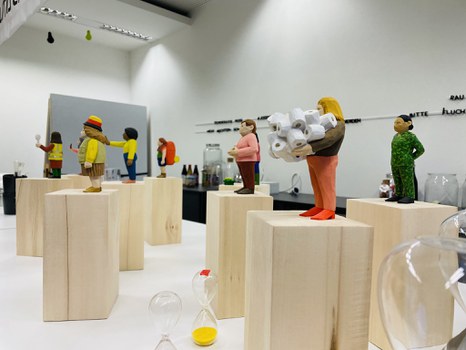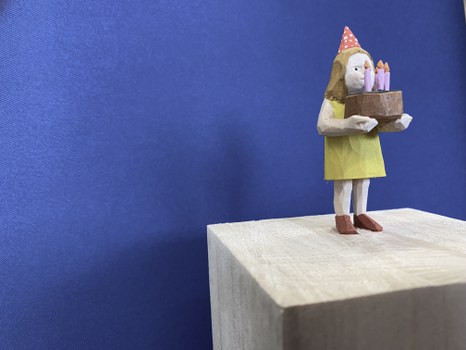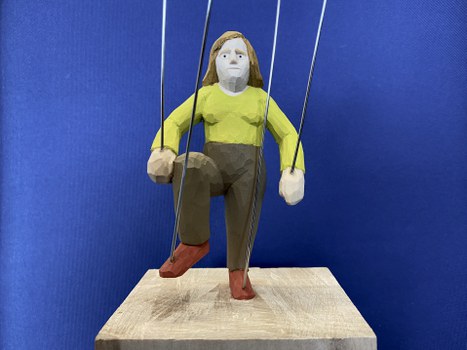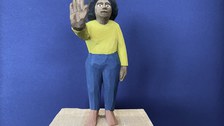Holzbürgerinnen
In der politischen Bildung steht die Förderung von Bürger:innenkompetenzen im Vordergrund. Doch welche Bürger:innen sind damit gemeint? Aktivbürger:innen, Interventionsbürger:innen oder mündige Bürger:innen? Welches Bild von Bürger:innen haben wir im Kopf? Sicherlich nicht das von passiven, desinteressierten und unmündigen Subjekten. Es ist daher lohnenswert, diesen Aspekt genauer zu betrachten. Zur Unterstützung haben wir vor einiger Zeit das Beratungsmaterial "Holzbürgerinnen" entwickelt.
Viele von Ihnen sind bereits mit unseren "Holzbürgerinnen" vertraut und schätzen sie als vielseitig einsetzbares Material. Aufgrund der großen Nachfrage und Ihren Rückmeldungen haben wir beschlossen, das ursprünglich aus Holz gefertigte Material weiterzuentwickeln. Wir freuen uns, Ihnen eine angepasste Version vorstellen zu können: Bierdeckel, gestaltet im Design der Holzbürger:innen, die die Vielfalt und Aktivität der Bürger:innen symbolisieren und ab sofort bei uns bestellt werden können.
Einsatzmöglichkeiten
Selbstreflexion:
Nutzen Sie das Material, um eigene Vorstellungen von Bürgerschaft und Engagement zu hinterfragen und zu reflektieren.
Einsatz in der Arbeit mit Multiplikator:innen und Zielgruppen:
Verwenden Sie die Bierdeckel in interaktiven Workshops, um Diskussionen und Reflexionen über Bürger:innenleitbilder anzustoßen.
Zugänge und Ziele
Zugänglichkeit der Bildungsangebote:
Fragen Sie sich und Ihre Teilnehmenden, wie zugänglich Ihre Angebote sind. Wen möchten Sie damit ansprechen. Wen spricht es tatsächlich an? Wen erreichen Sie nicht? Wie muss das Angebot gestaltet sein, um möglichst für alle zugänglich zu sein?
Reflexion von Zielperspektiven:
Nutzen Sie das Material, um die Ziele und Perspektiven Ihrer Bildungsangebote zu reflektieren. Welche Bürger:innenkompetenzen sind wichtig? Worin zeigen Sie sich? Wie sollen die Teilnehmenden aus Ihrer Veranstaltung rausgehen? Wie verstehen Sie sich selbst danach? Wen verstehen Sie?
Reflexion eigener Projektionen:
Reflektieren Sie mit Hilfe der Holzbürger:innen, wie Sie (mögliche) Teilnehmende Ihrer Angebote wahrnehmen. Was sehen Sie und was übersehen Sie möglicherweise? Welche Zuschreibungen basieren möglicherweise auf eigenen Projektionen oder Vorurteilen? Wie kann dem entgegengewirkt werden?
Spielweisen
Eigenschaften zuordnen:
Lassen Sie Eigenschaften aufschreiben und ordnen Sie diese den Holzbürger:innen zu. Diskutieren Sie anschließend, welche Eigenschaften beispielsweise für Mündigkeit, als zentrales Konzept der politischen Bildung, besonders relevant sind und wie sich diese fördern lassen könnten. Erörtern Sie auch, welche positive Funktionen scheinbar negativ besetzte Eigenschaften haben können. Reflektieren Sie über die Schattenseiten von positiv konnotierten Eigenschaften. Überlegen Sie, was dies für Ihre eigene politische Bildung bedeutet.
Kontaktanzeige oder Steckbrief erstellen:
Lassen Sie einen Steckbrief oder eine Kontaktanzeige für die Holzbürger:innen erstellen. Welche Bedürfnisse, Hoffnungen und Herausforderungen im Kontext politischer Bildung lassen sich aus den Kontaktanzeigen ableiten? Diskutieren Sie, wie Bildungsangebote gestaltet sein sollten, um auf die vielfältigen Bedürfnisse und Herausforderungen einzugehen, die in den Kontaktanzeigen zum Ausdruck kommen. Wie könnte eine diesbezüglich ansprechende Gestaltung ihrer Bildungsangebote aussehen?
Rollenwechsel:
Verteilen Sie die Bierdeckel und lassen Sie die Teilnehmenden aus der Perspektive der darauf abgebildeten Bürger:in sprechen. Fragen Sie beispielsweise, warum diese Person an einer Veranstaltung teilnehmen oder ihr fernbleiben würde, welche Bedürfnisse und Erwartungen hat sie und warum wäre ihre Perspektive für eine bestimmte thematische Debatte wichtig?
Informationen zur Bestellung
Für politische Bildner:innen in Sachsen ist die Bestellung und der Verleih von Materialien kostenfrei. Alle relevanten Informationen zur Bestellung finden Sie unter "Bestellinformationen".
Gerne stehen wir Ihnen weiterhin für Workshops oder Inputs zur Verfügung, in denen wir auch unsere eigentlichen Holzbürger:innen einsetzen. Für Anfragen wenden Sie sich bitte an joddid@tu-dresden.de.






































